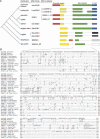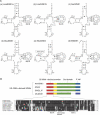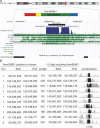Functional noncoding sequences derived from SINEs in the mammalian genome
- PMID: 16717141
- PMCID: PMC1484453
- DOI: 10.1101/gr.5255506
Functional noncoding sequences derived from SINEs in the mammalian genome
Abstract
Recent comparative analyses of mammalian sequences have revealed that a large number of nonprotein-coding genomic regions are under strong selective constraint. Here, we report that some of these loci have been derived from a newly defined family of ancient SINEs (short interspersed repetitive elements). This is a surprising result, as SINEs and other transposable elements are commonly thought to be genomic parasites. We named the ancient SINE family AmnSINE1, for Amniota SINE1, because we found it to be present in mammals as well as in birds, and some copies predate the mammalian-bird split 310 million years ago (Mya). AmnSINE1 has a chimeric structure of a 5S rRNA and a tRNA-derived SINE, and is related to five tRNA-derived SINE families that we characterized here in the coelacanth, dogfish shark, hagfish, and amphioxus genomes. All of the newly described SINE families have a common central domain that is also shared by zebrafish SINE3, and we collectively name them the DeuSINE (Deuterostomia SINE) superfamily. Notably, of the approximately 1000 still identifiable copies of AmnSINE1 in the human genome, 105 correspond to loci phylogenetically highly conserved among mammalian orthologs. The conservation is strongest over the central domain. Thus, AmnSINE1 appears to be the best example of a transposable element of which a significant fraction of the copies have acquired genomic functionality.
Figures







Similar articles
-
A novel class of SINE elements derived from 5S rRNA.Mol Biol Evol. 2003 May;20(5):694-702. doi: 10.1093/molbev/msg075. Epub 2003 Apr 2. Mol Biol Evol. 2003. PMID: 12679554
-
Novel SINE families from salmons validate Parahucho (Salmonidae) as a distinct genus and give evidence that SINEs can incorporate LINE-related 3'-tails of other SINEs.Mol Biol Evol. 2007 Aug;24(8):1656-66. doi: 10.1093/molbev/msm083. Epub 2007 Apr 29. Mol Biol Evol. 2007. PMID: 17470437
-
5S rRNA-derived and tRNA-derived SINEs in fruit bats.Genomics. 2009 May;93(5):494-500. doi: 10.1016/j.ygeno.2009.02.001. Epub 2009 Feb 12. Genomics. 2009. PMID: 19442632
-
SINEs as driving forces in genome evolution.Genome Dyn. 2012;7:92-107. doi: 10.1159/000337117. Epub 2012 Jun 25. Genome Dyn. 2012. PMID: 22759815 Review.
-
Carnivore-specific SINEs (Can-SINEs): distribution, evolution, and genomic impact.J Hered. 2011 Sep-Oct;102 Suppl 1(Suppl 1):S2-10. doi: 10.1093/jhered/esr051. J Hered. 2011. PMID: 21846743 Free PMC article. Review.
Cited by
-
Implication of a new function of human tDNAs in chromatin organization.Sci Rep. 2020 Oct 15;10(1):17440. doi: 10.1038/s41598-020-74499-7. Sci Rep. 2020. PMID: 33060757 Free PMC article.
-
New Ther1-derived SINE Squam3 in scaled reptiles.Mob DNA. 2021 Mar 22;12(1):10. doi: 10.1186/s13100-021-00238-y. Mob DNA. 2021. PMID: 33752750 Free PMC article.
-
Curation Guidelines for de novo Generated Transposable Element Families.Curr Protoc. 2021 Jun;1(6):e154. doi: 10.1002/cpz1.154. Curr Protoc. 2021. PMID: 34138525 Free PMC article.
-
Members of a large retroposon family are determinants of post-transcriptional gene expression in Leishmania.PLoS Pathog. 2007 Sep 7;3(9):1291-307. doi: 10.1371/journal.ppat.0030136. PLoS Pathog. 2007. PMID: 17907803 Free PMC article.
-
Fast-evolving noncoding sequences in the human genome.Genome Biol. 2007;8(6):R118. doi: 10.1186/gb-2007-8-6-r118. Genome Biol. 2007. PMID: 17578567 Free PMC article.
References
-
- Altschul S.F., Gish W., Miller W., Myers E.W., Lipman D.J., Gish W., Miller W., Myers E.W., Lipman D.J., Miller W., Myers E.W., Lipman D.J., Myers E.W., Lipman D.J., Lipman D.J. Basic local alignment search tool. J. Mol. Biol. 1990;215:403–410. - PubMed
-
- Bejerano G., Pheasant M., Makunin I., Stephen S., Kent W.J., Mattick J.S., Haussler D., Pheasant M., Makunin I., Stephen S., Kent W.J., Mattick J.S., Haussler D., Makunin I., Stephen S., Kent W.J., Mattick J.S., Haussler D., Stephen S., Kent W.J., Mattick J.S., Haussler D., Kent W.J., Mattick J.S., Haussler D., Mattick J.S., Haussler D., Haussler D. Ultraconserved elements in the human genome. Science. 2004a;304:1321–1325. - PubMed
-
- Bejerano G., Haussler D., Blanchette M., Haussler D., Blanchette M., Blanchette M. Into the heart of darkness: Large-scale clustering of human non-coding DNA. Bioinformatics. 2004b;20(Suppl 1):I40–I48. - PubMed
-
- Bejerano G., Lowe C., Ahituv N., King B., Siepel A., Salama S., Rubin E.M., Kent W.J., Haussler D., Lowe C., Ahituv N., King B., Siepel A., Salama S., Rubin E.M., Kent W.J., Haussler D., Ahituv N., King B., Siepel A., Salama S., Rubin E.M., Kent W.J., Haussler D., King B., Siepel A., Salama S., Rubin E.M., Kent W.J., Haussler D., Siepel A., Salama S., Rubin E.M., Kent W.J., Haussler D., Salama S., Rubin E.M., Kent W.J., Haussler D., Rubin E.M., Kent W.J., Haussler D., Kent W.J., Haussler D., Haussler D. A distal enhancer and ultraconserved exon are derived from a novel retroposon. Nature. 2006;441:87–90. - PubMed
-
- Benton M.J. Vertebrate paleontology. Chapman & Hall; New York: 1997.
Publication types
MeSH terms
Substances
Associated data
- Actions
- Actions
- Actions
- Actions
- Actions
- Actions
Grants and funding
LinkOut - more resources
Full Text Sources
